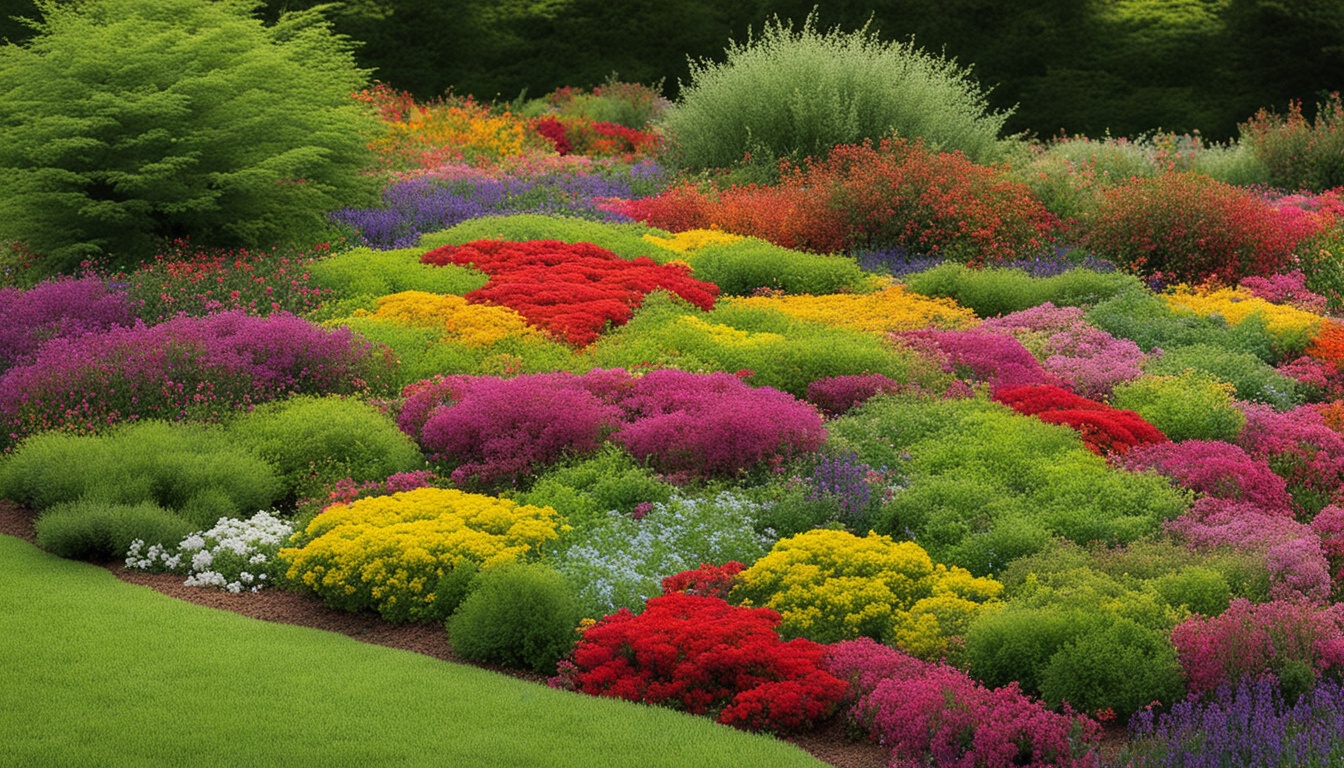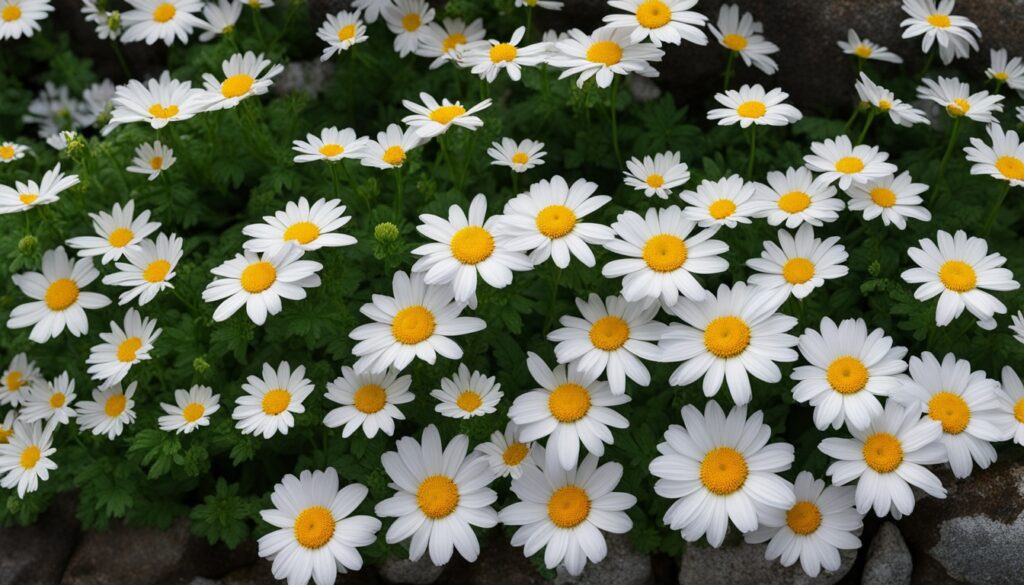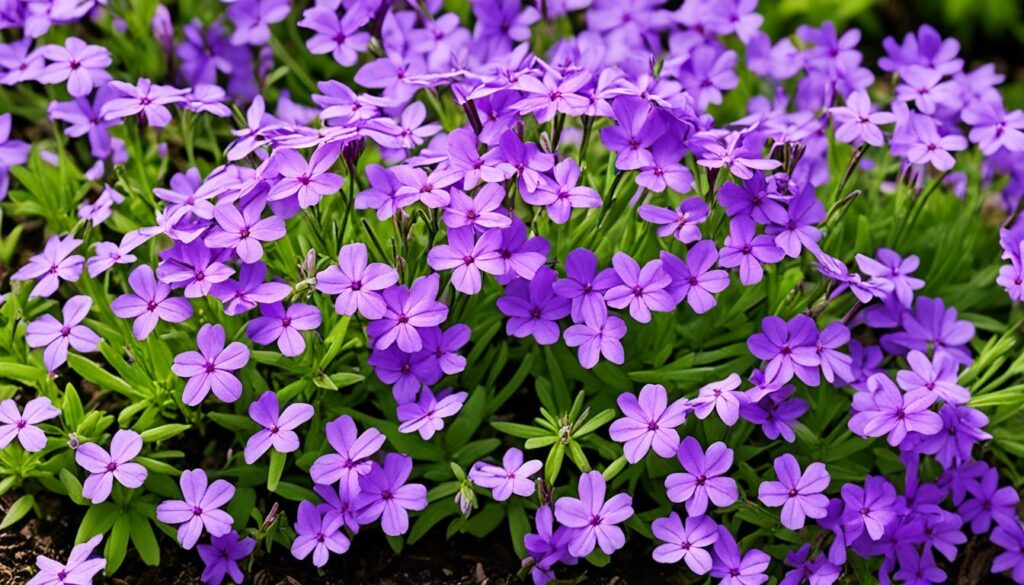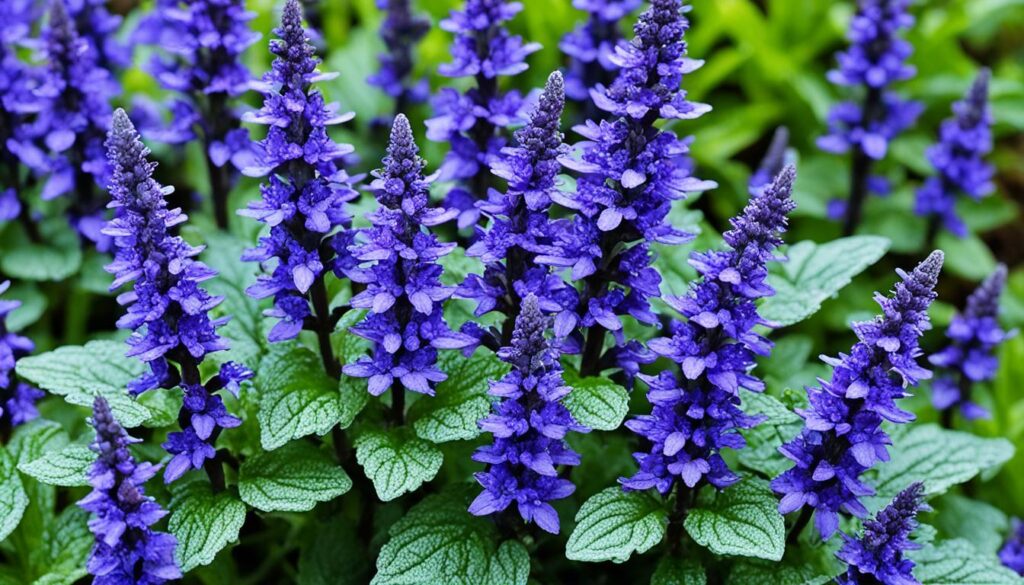Ground cover plants offer practical and aesthetic benefits in gardens. They manage weeds, stop soil from washing away, and beautify spaces naturally. Fast-growing types are especially valuable, quickly turning bare areas into bursts of color. Here are 12 options for you, bringing life and color to your garden.
Key Takeaways:
- Ground cover plants are a practical and aesthetic addition to any garden.
- They can help manage weeds and prevent soil erosion.
- Fast-growing ground cover plants provide quick coverage and vibrant foliage.
- Consider these 12 ideas to transform your garden with color and beauty.
- Choose plants that are suitable for your specific growing conditions.
1. Erigeron karvinskianus (Mexican Daisy)
Erigeron karvinskianus, or Mexican daisy, is a ground cover plant. It loves rocky, dry spots. This plant makes beautiful mounds covered in tiny daisy flowers. You’ll see these flowers from summer until fall. It makes gardens look wild and brings beauty to rocky places. But, be careful, it can take over gardens that are too tidy.
This plant is tough and can live in places from zone 6 to 9 in the US. It can reach up to 2 feet in height and spread across 5 feet. People love it for its pretty flowers and how it makes hard places beautiful.
2. Lamium maculatum
Lamium maculatum is a great ground cover for dry, shady areas. It’s known as spotted dead nettle. This plant looks beautiful with its colorful leaves and delicate flowers. It brings elegance to your garden.
This plant does well in areas with little sun. Lamium maculatum thrives in dry, shady places. It’s a perfect choice for adding color and texture to forgotten garden spots. It does not need a lot of care.
In summer, it blooms with small, white or purple flowers. These flowers look pretty among the green leaves. They also attract helpful pollinators.
It spreads fast, thanks to its root runners. This covers bare spots well. It’s great for big areas needing ground cover.
Lamium maculatum doesn’t need much looking after. Once it’s grown, it’s quite independent. It can handle times without rain. So, it’s a good plant for those who don’t want to always be gardening.
It usually grows to be 12 inches tall with a 12-inch spread. This plant does well in many climate zones. It can live in USDA zones 3-8.
If your garden has dry, shady areas, consider this plant. Its unique leaves and flowers add charm. Plus, it’s easy to care for. This makes it a top pick for gardeners.
3. Phlox subulata (Creeping Phlox)
Phlox subulata, known as creeping phlox, is a North American native. It does well in spots like slopes and rock gardens. This plant grows like a green carpet and is beautiful.
It shines in spring with flowers in white, purple, and magenta. These flowers stand out against its green leaves. It really catches the eye in any garden.
Creeping phlox is great for more than just looks. It doesn’t need much water, perfect for dry places. It keeps deer away and helps soil stay in place. These make it perfect for slopes and gardens of stone.
Many types of creeping phlox exist, with various flower colors. For example, ‘McDaniels Cushion’ and ‘Emerald Blue’ can brighten up your garden.
This plant isn’t picky and can grow almost anywhere. It stays low, only 4 inches high and 16 inches wide. It’s happy in places from zone 3 to 9, meaning it fits in lots of different climates.
4. Bugleweed (Ajuga reptans)
Bugleweed, also known as Ajuga reptans, is a plant that stays low to the ground. It does well in areas with light shade. This plant has dark leaves that feel bumpy and look interesting. In the late spring and early summer, it blooms with bright purple-blue flowers. These flowers are loved by bees and other pollinators. Bugleweed is known for being tough and growing quickly. This makes it perfect for the front edges of gardens or for filling empty spaces. It looks especially nice when planted next to other plants that like shade. This creates a nice balance of colors and shapes in your garden.
There are many types of Bugleweed to choose from, like ‘Black Scallop’ and ‘Catlin’s Giant’. Each kind has its own special size and leaf color. This variety lets you pick the Bugleweed that fits your garden best.
Bugleweed usually gets about 6 inches tall and spreads to 18 inches wide. This means it can cover a good amount of space in your garden. It can survive the cold in USDA zones 4-10, so it’s good for many places.
Benefits of Bugleweed:
- Adds texture and visual interest with its dark foliage
- Produces vibrant purple-blue flowers
- Hardy and fast-growing
- Great for the front of borders or filling in bare spots
- Pairs well with shade-tolerant plants for contrast
- Available in various varieties for different leaf sizes and colors
Conclusion
Ground cover plants are a great choice for big garden areas. They’re easy to take care of and cover areas quickly. By planting these flowering ground covers, your garden won’t just look good. It will also keep away weeds and stop soil from eroding.
There are 12 quick-growing ground cover plants we talked about. They come in many colors and feel soft when you touch them. From Mexican daisies to creeping phlox, these plants are tough and can handle different growing spots. This makes them perfect for any garden.
Do you want more color in your garden or dream of a lush paradise? These ground cover plants are the answer. They will beautify your garden and keep it looking great with little effort.




